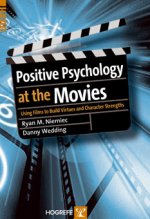 | Positive Psychology at the Movies A book by Ryan M. Niemiec & Danny Wedding Published in 2008 Find in a library |
By Derrick Carpenter
Positive Psychology News
October 22, 2008
I often find there are certain themes or ideas that – although previously unexplored – all of a sudden come to my attention over and over again until they cannot be ignored. During the course of my positive psychology education, many such ideas crossed my path. And among them was the film Groundhog Day. I had never seen the film, but I kept hearing that the 1993 classic was an exemplar of positive psychology tenets. So a few weeks back I decided to give in to my curiosity. Bill Murray’s character, a sarcastic and surly local weatherman, keeps waking up to live the same day over again. As the film progresses and Murray’s character learns that he has ultimate control over how happy he will be in his never-ending purgatory, he transforms his attitude and eventually becomes the kind-hearted town hero. I loved the film so much I watched it again the next night.
Besides eliciting positive emotions in the viewer, Groundhog Day is a fantastic visual display of the character strength of gratitude. Films, which intrinsically revolve around the study and exploration of character, are a terrific medium for a journey through the VIA character strengths. A new book published this summer, Positive Psychology at the Movies: Using Films to Build Virtues and Character Strengths, by psychologists Ryan M. Niemiec and Danny Wedding perfectly lays the landscape for this wonderful journey of positive psychology in film. The well-structured text provides an endless selection of films with character strengths and virtues as dominant themes. It becomes clear at first glance that the authors have a thorough fundamental understanding of positive psychology, extensive experience in critiquing and evaluating films, and a true passion for uniting the two.
With an introductory chapter on the foundations and history of positive psychology, the book is appropriate for positive psychology novices, but the added perspective of film keeps everything fresh for experts. The bulk of the book is structured around the 24 VIA strengths. For each strength Niemiec and Wedding first discuss the key concepts and relevant research. While the authors inject opinion from time to time, these sections are great stand-alone summaries on the strengths. Each strength is then discussed in the context of relevant films and film characters, including a section on portrayals of the opposite of each strength and a section focusing solely on international film.
The major highlights of the book, besides the writing itself, which is both entertaining and academically rigorous, are found in special sections. Each section on a given strength includes a set of Practical Applications. While these lists of recommendations on how to cultivate a strength occasionally involve film references, they encompass a very general set of guidelines and interventions. Anyone who followed all of the suggestions for a given strength would certainly notice improvements. These lists are fantastic resources for positive psychology practitioners. Additionally, the set of appendices is a must read. The authors have cited a single best exemplar film for each of the 24 strengths, as well as fuller list of movies, ranging from 11 to 131 per strength, rated on a scale from good to excellent. These lists could fill your film-watching agenda for years. Suggested discussion questions for classrooms or therapy, a brief selection of suggested clips for presentations or lectures, and an example of a positive psychology syllabus incorporating film are all nice bonuses.
Niemiec and Wedding have put so much care and attention into their research and choices that I believe this book is a must for positive psychology instructors who intend to integrate film into their lectures. Anyone working as a coach, consultant, or professional using positive psychology can both use the book as a resource to incorporate film as necessary into their work and to refresh and revitalize their perspective on positive psychology through film. And for the casual PPND subscriber, Positive Psychology at the Movies can help guide you to films that will encourage discussion among family and friends about the presence of character strengths in your own lives.
As I thoughtfully added Groundhog Day to my select list of favorite films, Niemiec and Wedding’s wonderful volume has me adding new films to my must-see list by the dozens. I found it ironical that among their well-crafted practical applications, one of their recommendations for increasing vitality is to “spend less time watching television or in front of a computer monitor” (p. 78). I figure if we have any chance of succeeding, we ought to fill the television time we do have with substance that matters and encourages character evaluation. Positive Psychology at the Movies will immediately take you to the great films you should be watching.
Note: The book's listing of positive psychology movies
 is freely available.
is freely available.